Nursing BGL Case Study 2022
VerifiedAdded on 2022/10/15
|8
|1622
|13
AI Summary
Contribute Materials
Your contribution can guide someone’s learning journey. Share your
documents today.
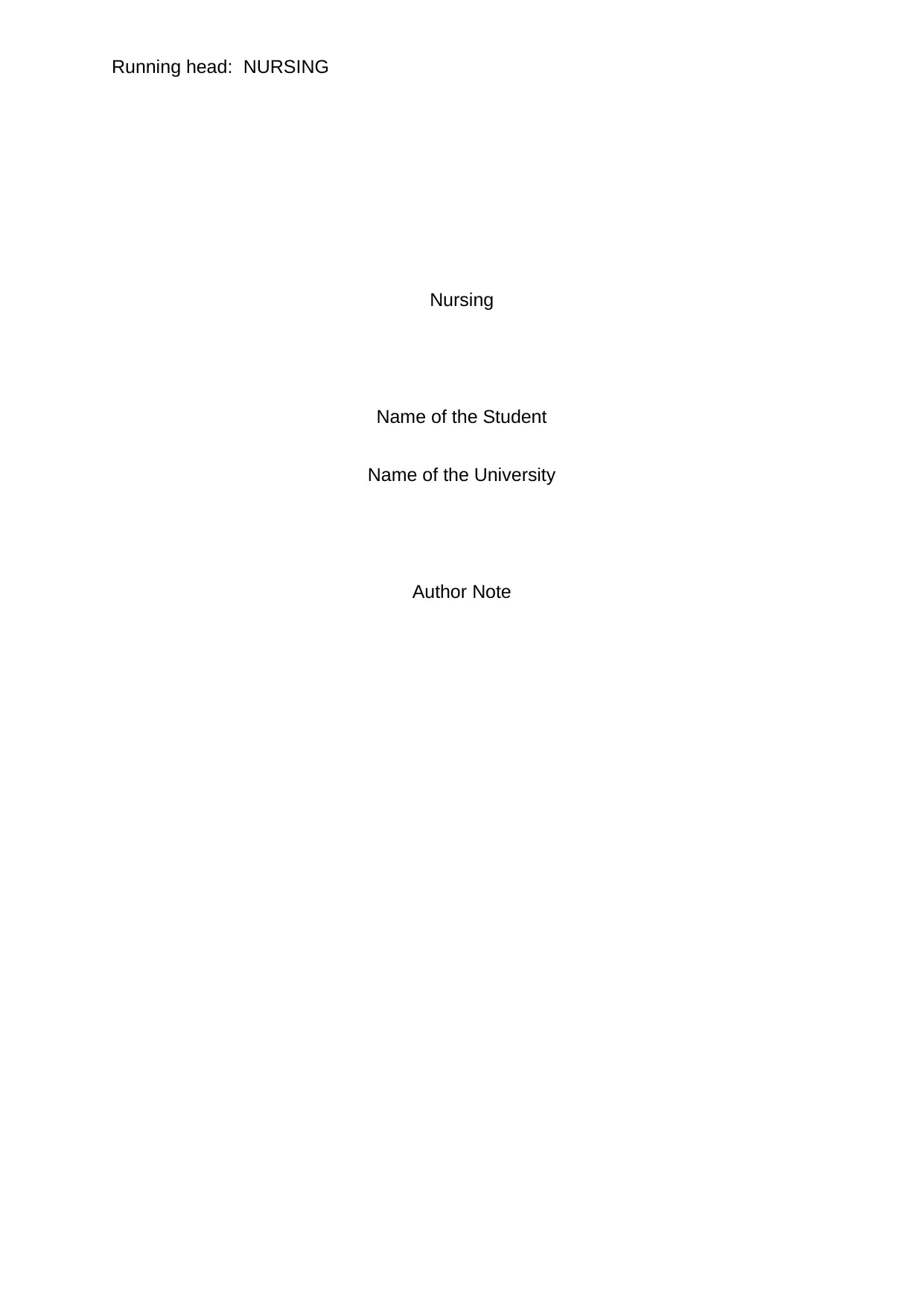
Running head: NURSING
Nursing
Name of the Student
Name of the University
Author Note
Nursing
Name of the Student
Name of the University
Author Note
Secure Best Marks with AI Grader
Need help grading? Try our AI Grader for instant feedback on your assignments.
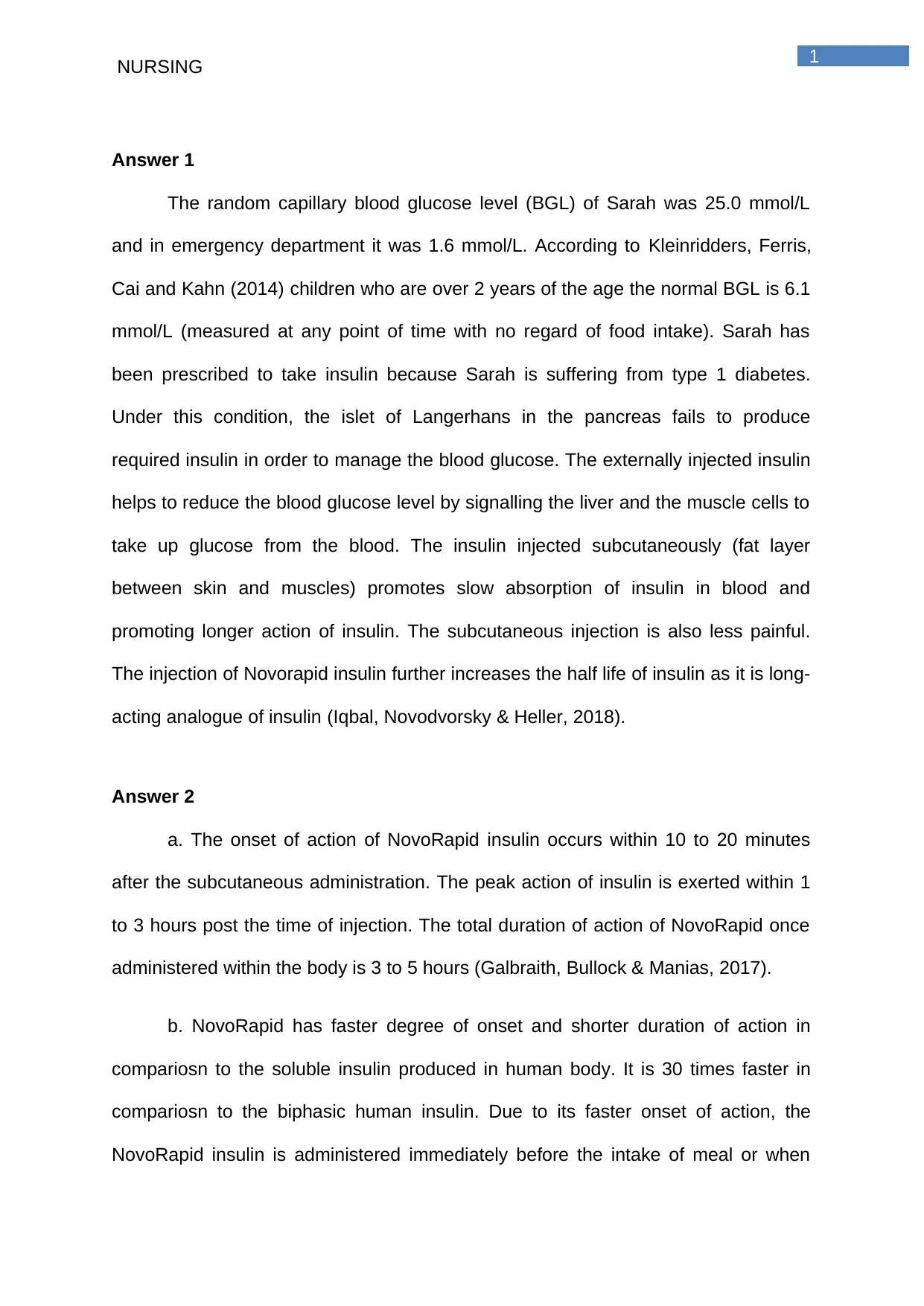
1
NURSING
Answer 1
The random capillary blood glucose level (BGL) of Sarah was 25.0 mmol/L
and in emergency department it was 1.6 mmol/L. According to Kleinridders, Ferris,
Cai and Kahn (2014) children who are over 2 years of the age the normal BGL is 6.1
mmol/L (measured at any point of time with no regard of food intake). Sarah has
been prescribed to take insulin because Sarah is suffering from type 1 diabetes.
Under this condition, the islet of Langerhans in the pancreas fails to produce
required insulin in order to manage the blood glucose. The externally injected insulin
helps to reduce the blood glucose level by signalling the liver and the muscle cells to
take up glucose from the blood. The insulin injected subcutaneously (fat layer
between skin and muscles) promotes slow absorption of insulin in blood and
promoting longer action of insulin. The subcutaneous injection is also less painful.
The injection of Novorapid insulin further increases the half life of insulin as it is long-
acting analogue of insulin (Iqbal, Novodvorsky & Heller, 2018).
Answer 2
a. The onset of action of NovoRapid insulin occurs within 10 to 20 minutes
after the subcutaneous administration. The peak action of insulin is exerted within 1
to 3 hours post the time of injection. The total duration of action of NovoRapid once
administered within the body is 3 to 5 hours (Galbraith, Bullock & Manias, 2017).
b. NovoRapid has faster degree of onset and shorter duration of action in
compariosn to the soluble insulin produced in human body. It is 30 times faster in
compariosn to the biphasic human insulin. Due to its faster onset of action, the
NovoRapid insulin is administered immediately before the intake of meal or when
NURSING
Answer 1
The random capillary blood glucose level (BGL) of Sarah was 25.0 mmol/L
and in emergency department it was 1.6 mmol/L. According to Kleinridders, Ferris,
Cai and Kahn (2014) children who are over 2 years of the age the normal BGL is 6.1
mmol/L (measured at any point of time with no regard of food intake). Sarah has
been prescribed to take insulin because Sarah is suffering from type 1 diabetes.
Under this condition, the islet of Langerhans in the pancreas fails to produce
required insulin in order to manage the blood glucose. The externally injected insulin
helps to reduce the blood glucose level by signalling the liver and the muscle cells to
take up glucose from the blood. The insulin injected subcutaneously (fat layer
between skin and muscles) promotes slow absorption of insulin in blood and
promoting longer action of insulin. The subcutaneous injection is also less painful.
The injection of Novorapid insulin further increases the half life of insulin as it is long-
acting analogue of insulin (Iqbal, Novodvorsky & Heller, 2018).
Answer 2
a. The onset of action of NovoRapid insulin occurs within 10 to 20 minutes
after the subcutaneous administration. The peak action of insulin is exerted within 1
to 3 hours post the time of injection. The total duration of action of NovoRapid once
administered within the body is 3 to 5 hours (Galbraith, Bullock & Manias, 2017).
b. NovoRapid has faster degree of onset and shorter duration of action in
compariosn to the soluble insulin produced in human body. It is 30 times faster in
compariosn to the biphasic human insulin. Due to its faster onset of action, the
NovoRapid insulin is administered immediately before the intake of meal or when

2
NURSING
necessary like immediately after the intake of meal (Galbraith, Bullock & Manias,
2017).
Answer 3
a. Hypoglycemia is defined as a condition where the blood glucose level falls
below normal (International Hypoglycaemia Study Group, 2015).
b. In case of patients suffering from type 1 diabetes mellitus, hypoglycemia
can occur when the patient is under subcutaneous insulin injection and also
performs high intensity physical activity simultaneously. Like in case of Sarah, intake
of NovoRapid (three times per day) along with taking swimming lessons and dance
classes might lead to generation of hypoglycemia. Insulin over-dose in glycemic
patients can also cause diabetes (International Hypoglycaemia Study Group, 2015).
c. The main symptoms of hypoglycemia include shakiness, dizziness, profuse
sweating, nervousness, anxiety and in extreme cases, it might lead to numbness of
hand and feet, sudden drop in body temperature and loss of consciousness
(International Hypoglycaemia Study Group, 2015).
d. The immediate and best treatment for hypoglcemia include consumption of
at least 15 to 20 grams of fast action carbohydrate like sugar or fruit juice in order to
restore the glucose balance in body (International Hypoglycaemia Study Group,
2015).
Answer 4
a. Bergenstal et al. (2015) stated that shorter needles ensure lower degree of
pain upon injection. The length of the needle varies with age and the dosage of
NURSING
necessary like immediately after the intake of meal (Galbraith, Bullock & Manias,
2017).
Answer 3
a. Hypoglycemia is defined as a condition where the blood glucose level falls
below normal (International Hypoglycaemia Study Group, 2015).
b. In case of patients suffering from type 1 diabetes mellitus, hypoglycemia
can occur when the patient is under subcutaneous insulin injection and also
performs high intensity physical activity simultaneously. Like in case of Sarah, intake
of NovoRapid (three times per day) along with taking swimming lessons and dance
classes might lead to generation of hypoglycemia. Insulin over-dose in glycemic
patients can also cause diabetes (International Hypoglycaemia Study Group, 2015).
c. The main symptoms of hypoglycemia include shakiness, dizziness, profuse
sweating, nervousness, anxiety and in extreme cases, it might lead to numbness of
hand and feet, sudden drop in body temperature and loss of consciousness
(International Hypoglycaemia Study Group, 2015).
d. The immediate and best treatment for hypoglcemia include consumption of
at least 15 to 20 grams of fast action carbohydrate like sugar or fruit juice in order to
restore the glucose balance in body (International Hypoglycaemia Study Group,
2015).
Answer 4
a. Bergenstal et al. (2015) stated that shorter needles ensure lower degree of
pain upon injection. The length of the needle varies with age and the dosage of

3
NURSING
injection. In case of child like Sarah, the distance from the skin and the fat tissue or
subcutaneous tissue is less and thus the length of the pen needle must be no longer
than 4 mm (Bergenstal et al., 2015).
b. This length is appropriate because, the short length will prevent the
penetration of the needle into the muscle cells and thus ensuring slow release of the
insulin and lesser pain (Bergenstal et al., 2015).
c. The dosage of Sarah is less that is 3 units thrice per day and Sarah goes to
Kindergarten. Depending on the dosage and age, this needle length is best suited for
her (Bergenstal et al., 2015).
Answer 6
a. There are four different areas in a child’s body, which is suitable for insulin
injection. These areas include thighs, abdomen, backside of the upper arms and
upper outer buttocks. It is recommended to rotate the site of insulin injection in order
to reduce the severity of pain (Frid et al., 2016).
b. The angle for insulin injection is 45 degree as Sarah is a child and creation
of bolus is important. However, if the needle size is short that is 4 mm then the angle
must be 90 degree in order to ensure that the insulin enters directly into the
subcutaneous layer (that is just below the skin) (Frid et al., 2016).
c. There areas are suitable for injecting insulin for Sarah because the upper
part of skin in these areas are thick and thus helping to prevent the penetration of the
needle into the muscle cells (Frid et al., 2016).
NURSING
injection. In case of child like Sarah, the distance from the skin and the fat tissue or
subcutaneous tissue is less and thus the length of the pen needle must be no longer
than 4 mm (Bergenstal et al., 2015).
b. This length is appropriate because, the short length will prevent the
penetration of the needle into the muscle cells and thus ensuring slow release of the
insulin and lesser pain (Bergenstal et al., 2015).
c. The dosage of Sarah is less that is 3 units thrice per day and Sarah goes to
Kindergarten. Depending on the dosage and age, this needle length is best suited for
her (Bergenstal et al., 2015).
Answer 6
a. There are four different areas in a child’s body, which is suitable for insulin
injection. These areas include thighs, abdomen, backside of the upper arms and
upper outer buttocks. It is recommended to rotate the site of insulin injection in order
to reduce the severity of pain (Frid et al., 2016).
b. The angle for insulin injection is 45 degree as Sarah is a child and creation
of bolus is important. However, if the needle size is short that is 4 mm then the angle
must be 90 degree in order to ensure that the insulin enters directly into the
subcutaneous layer (that is just below the skin) (Frid et al., 2016).
c. There areas are suitable for injecting insulin for Sarah because the upper
part of skin in these areas are thick and thus helping to prevent the penetration of the
needle into the muscle cells (Frid et al., 2016).
Secure Best Marks with AI Grader
Need help grading? Try our AI Grader for instant feedback on your assignments.
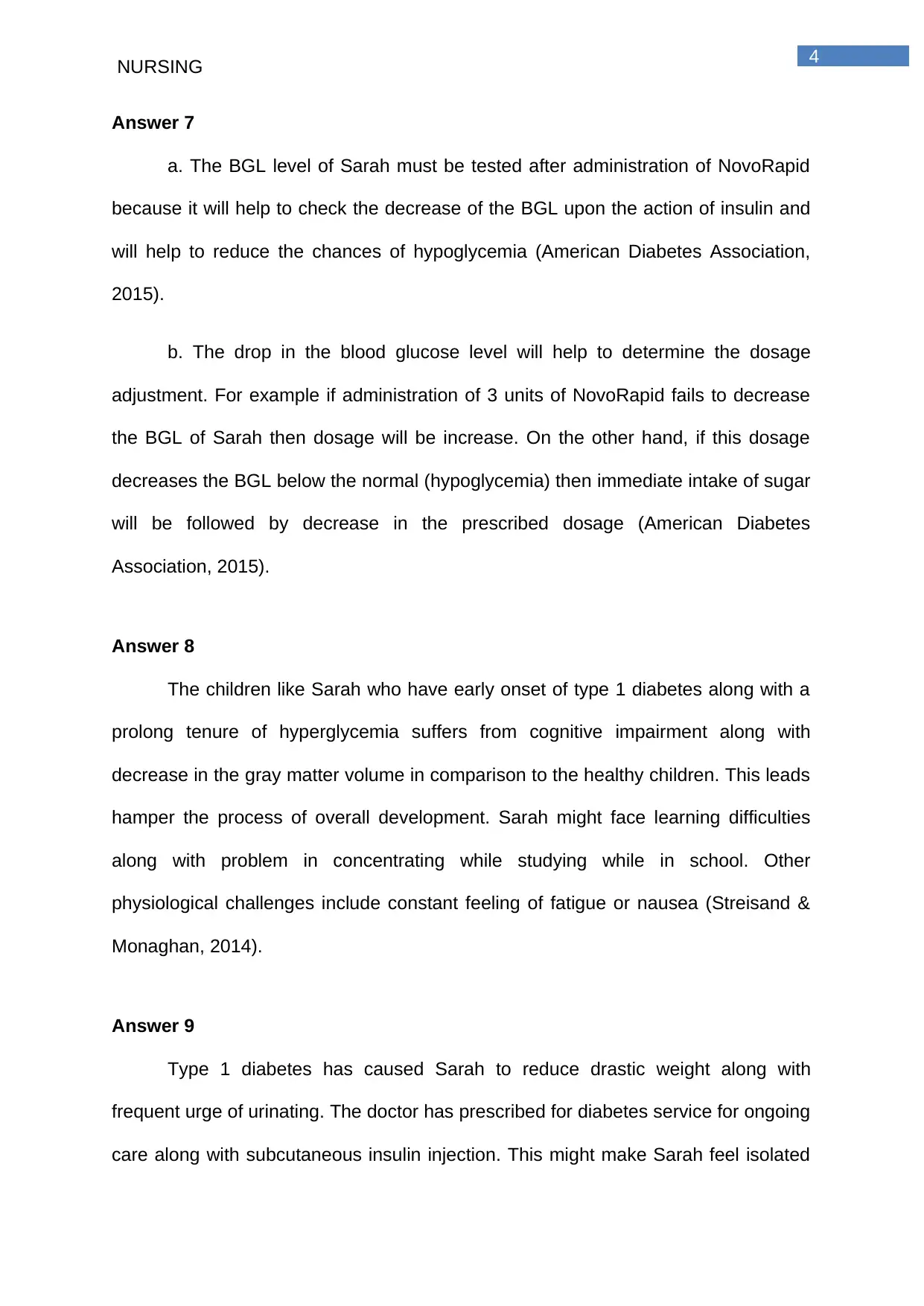
4
NURSING
Answer 7
a. The BGL level of Sarah must be tested after administration of NovoRapid
because it will help to check the decrease of the BGL upon the action of insulin and
will help to reduce the chances of hypoglycemia (American Diabetes Association,
2015).
b. The drop in the blood glucose level will help to determine the dosage
adjustment. For example if administration of 3 units of NovoRapid fails to decrease
the BGL of Sarah then dosage will be increase. On the other hand, if this dosage
decreases the BGL below the normal (hypoglycemia) then immediate intake of sugar
will be followed by decrease in the prescribed dosage (American Diabetes
Association, 2015).
Answer 8
The children like Sarah who have early onset of type 1 diabetes along with a
prolong tenure of hyperglycemia suffers from cognitive impairment along with
decrease in the gray matter volume in comparison to the healthy children. This leads
hamper the process of overall development. Sarah might face learning difficulties
along with problem in concentrating while studying while in school. Other
physiological challenges include constant feeling of fatigue or nausea (Streisand &
Monaghan, 2014).
Answer 9
Type 1 diabetes has caused Sarah to reduce drastic weight along with
frequent urge of urinating. The doctor has prescribed for diabetes service for ongoing
care along with subcutaneous insulin injection. This might make Sarah feel isolated
NURSING
Answer 7
a. The BGL level of Sarah must be tested after administration of NovoRapid
because it will help to check the decrease of the BGL upon the action of insulin and
will help to reduce the chances of hypoglycemia (American Diabetes Association,
2015).
b. The drop in the blood glucose level will help to determine the dosage
adjustment. For example if administration of 3 units of NovoRapid fails to decrease
the BGL of Sarah then dosage will be increase. On the other hand, if this dosage
decreases the BGL below the normal (hypoglycemia) then immediate intake of sugar
will be followed by decrease in the prescribed dosage (American Diabetes
Association, 2015).
Answer 8
The children like Sarah who have early onset of type 1 diabetes along with a
prolong tenure of hyperglycemia suffers from cognitive impairment along with
decrease in the gray matter volume in comparison to the healthy children. This leads
hamper the process of overall development. Sarah might face learning difficulties
along with problem in concentrating while studying while in school. Other
physiological challenges include constant feeling of fatigue or nausea (Streisand &
Monaghan, 2014).
Answer 9
Type 1 diabetes has caused Sarah to reduce drastic weight along with
frequent urge of urinating. The doctor has prescribed for diabetes service for ongoing
care along with subcutaneous insulin injection. This might make Sarah feel isolated
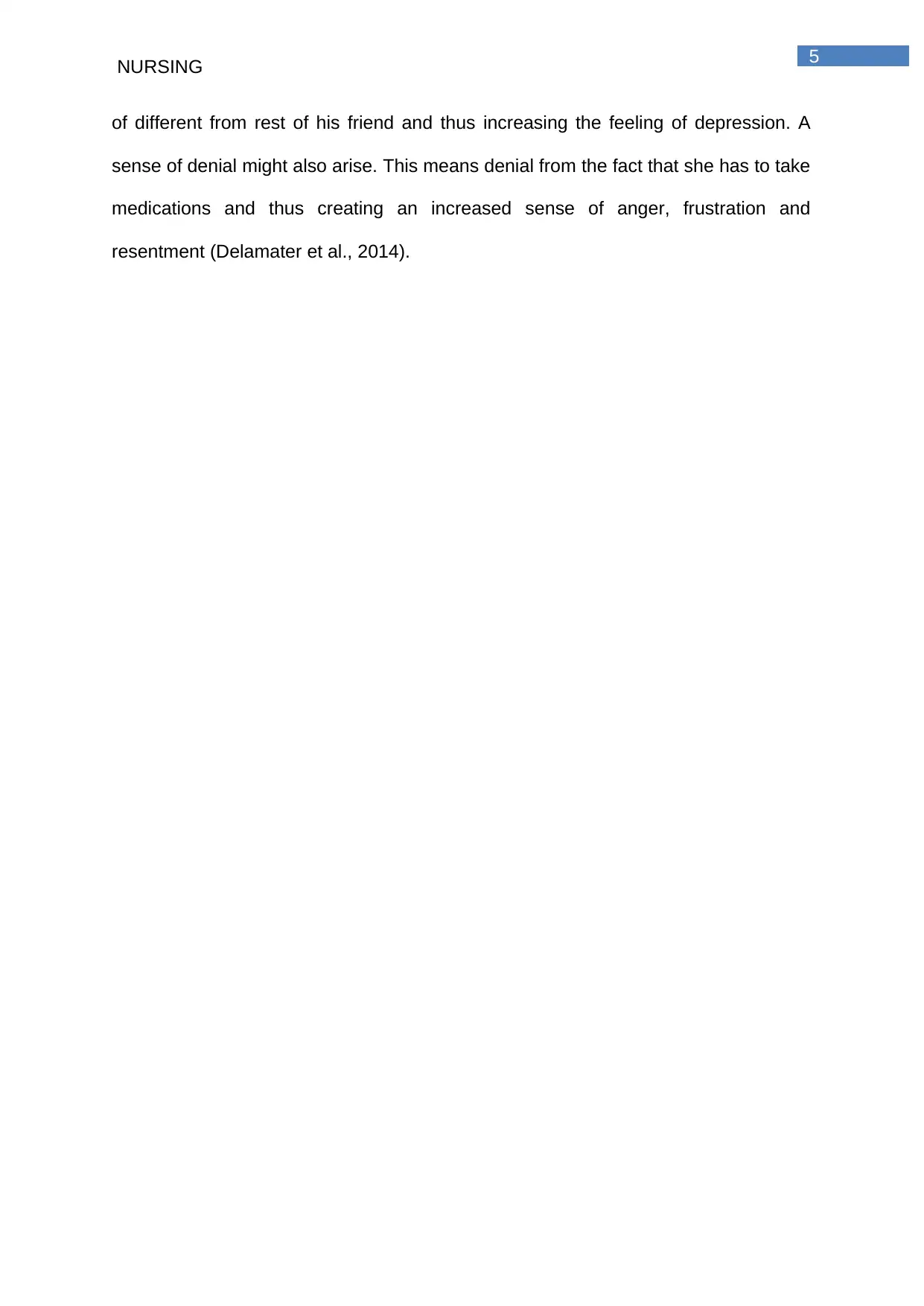
5
NURSING
of different from rest of his friend and thus increasing the feeling of depression. A
sense of denial might also arise. This means denial from the fact that she has to take
medications and thus creating an increased sense of anger, frustration and
resentment (Delamater et al., 2014).
NURSING
of different from rest of his friend and thus increasing the feeling of depression. A
sense of denial might also arise. This means denial from the fact that she has to take
medications and thus creating an increased sense of anger, frustration and
resentment (Delamater et al., 2014).
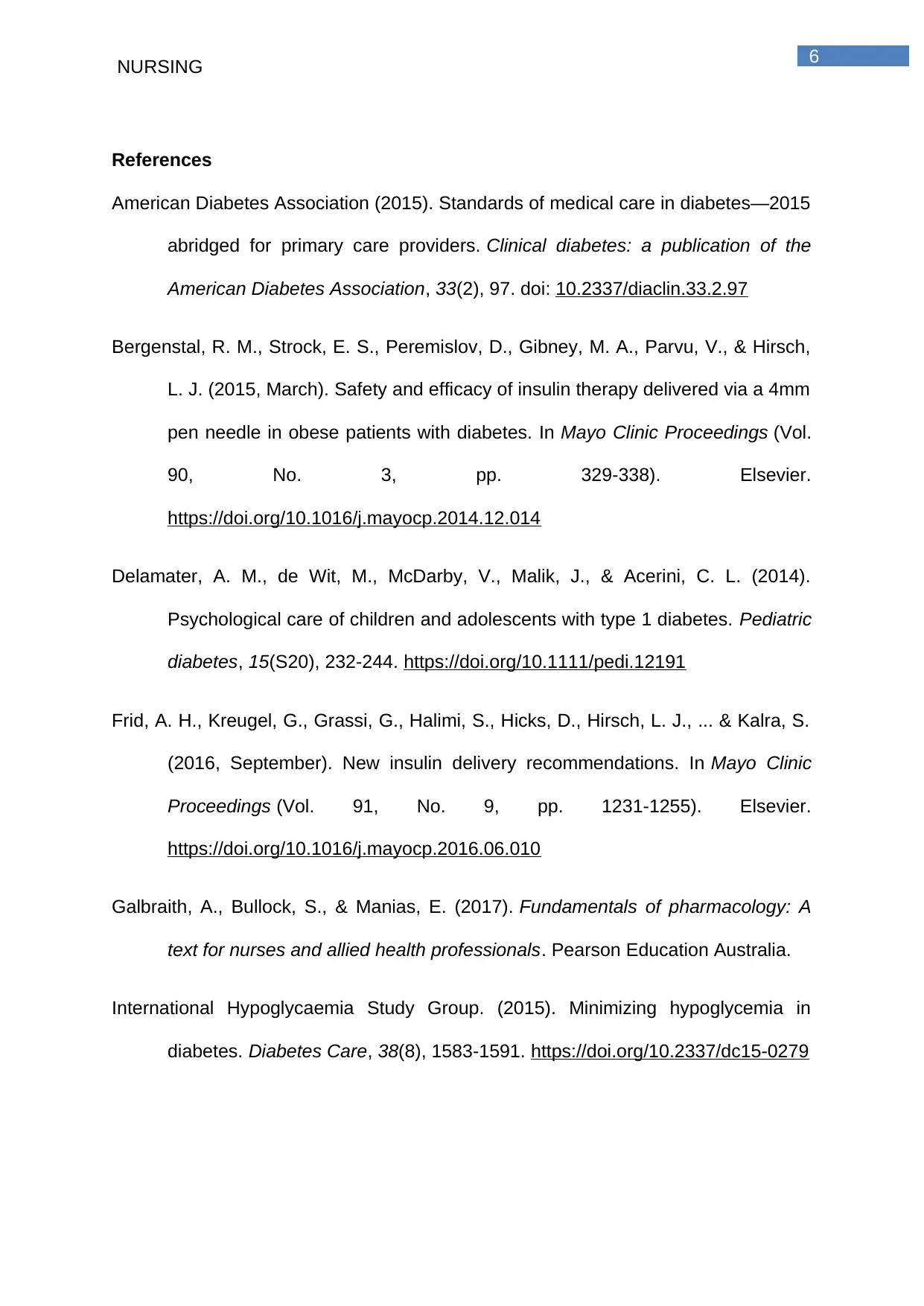
6
NURSING
References
American Diabetes Association (2015). Standards of medical care in diabetes—2015
abridged for primary care providers. Clinical diabetes: a publication of the
American Diabetes Association, 33(2), 97. doi: 10.2337/diaclin.33.2.97
Bergenstal, R. M., Strock, E. S., Peremislov, D., Gibney, M. A., Parvu, V., & Hirsch,
L. J. (2015, March). Safety and efficacy of insulin therapy delivered via a 4mm
pen needle in obese patients with diabetes. In Mayo Clinic Proceedings (Vol.
90, No. 3, pp. 329-338). Elsevier.
https://doi.org/10.1016/j.mayocp.2014.12.014
Delamater, A. M., de Wit, M., McDarby, V., Malik, J., & Acerini, C. L. (2014).
Psychological care of children and adolescents with type 1 diabetes. Pediatric
diabetes, 15(S20), 232-244. https://doi.org/10.1111/pedi.12191
Frid, A. H., Kreugel, G., Grassi, G., Halimi, S., Hicks, D., Hirsch, L. J., ... & Kalra, S.
(2016, September). New insulin delivery recommendations. In Mayo Clinic
Proceedings (Vol. 91, No. 9, pp. 1231-1255). Elsevier.
https://doi.org/10.1016/j.mayocp.2016.06.010
Galbraith, A., Bullock, S., & Manias, E. (2017). Fundamentals of pharmacology: A
text for nurses and allied health professionals. Pearson Education Australia.
International Hypoglycaemia Study Group. (2015). Minimizing hypoglycemia in
diabetes. Diabetes Care, 38(8), 1583-1591. https://doi.org/10.2337/dc15-0279
NURSING
References
American Diabetes Association (2015). Standards of medical care in diabetes—2015
abridged for primary care providers. Clinical diabetes: a publication of the
American Diabetes Association, 33(2), 97. doi: 10.2337/diaclin.33.2.97
Bergenstal, R. M., Strock, E. S., Peremislov, D., Gibney, M. A., Parvu, V., & Hirsch,
L. J. (2015, March). Safety and efficacy of insulin therapy delivered via a 4mm
pen needle in obese patients with diabetes. In Mayo Clinic Proceedings (Vol.
90, No. 3, pp. 329-338). Elsevier.
https://doi.org/10.1016/j.mayocp.2014.12.014
Delamater, A. M., de Wit, M., McDarby, V., Malik, J., & Acerini, C. L. (2014).
Psychological care of children and adolescents with type 1 diabetes. Pediatric
diabetes, 15(S20), 232-244. https://doi.org/10.1111/pedi.12191
Frid, A. H., Kreugel, G., Grassi, G., Halimi, S., Hicks, D., Hirsch, L. J., ... & Kalra, S.
(2016, September). New insulin delivery recommendations. In Mayo Clinic
Proceedings (Vol. 91, No. 9, pp. 1231-1255). Elsevier.
https://doi.org/10.1016/j.mayocp.2016.06.010
Galbraith, A., Bullock, S., & Manias, E. (2017). Fundamentals of pharmacology: A
text for nurses and allied health professionals. Pearson Education Australia.
International Hypoglycaemia Study Group. (2015). Minimizing hypoglycemia in
diabetes. Diabetes Care, 38(8), 1583-1591. https://doi.org/10.2337/dc15-0279
Paraphrase This Document
Need a fresh take? Get an instant paraphrase of this document with our AI Paraphraser
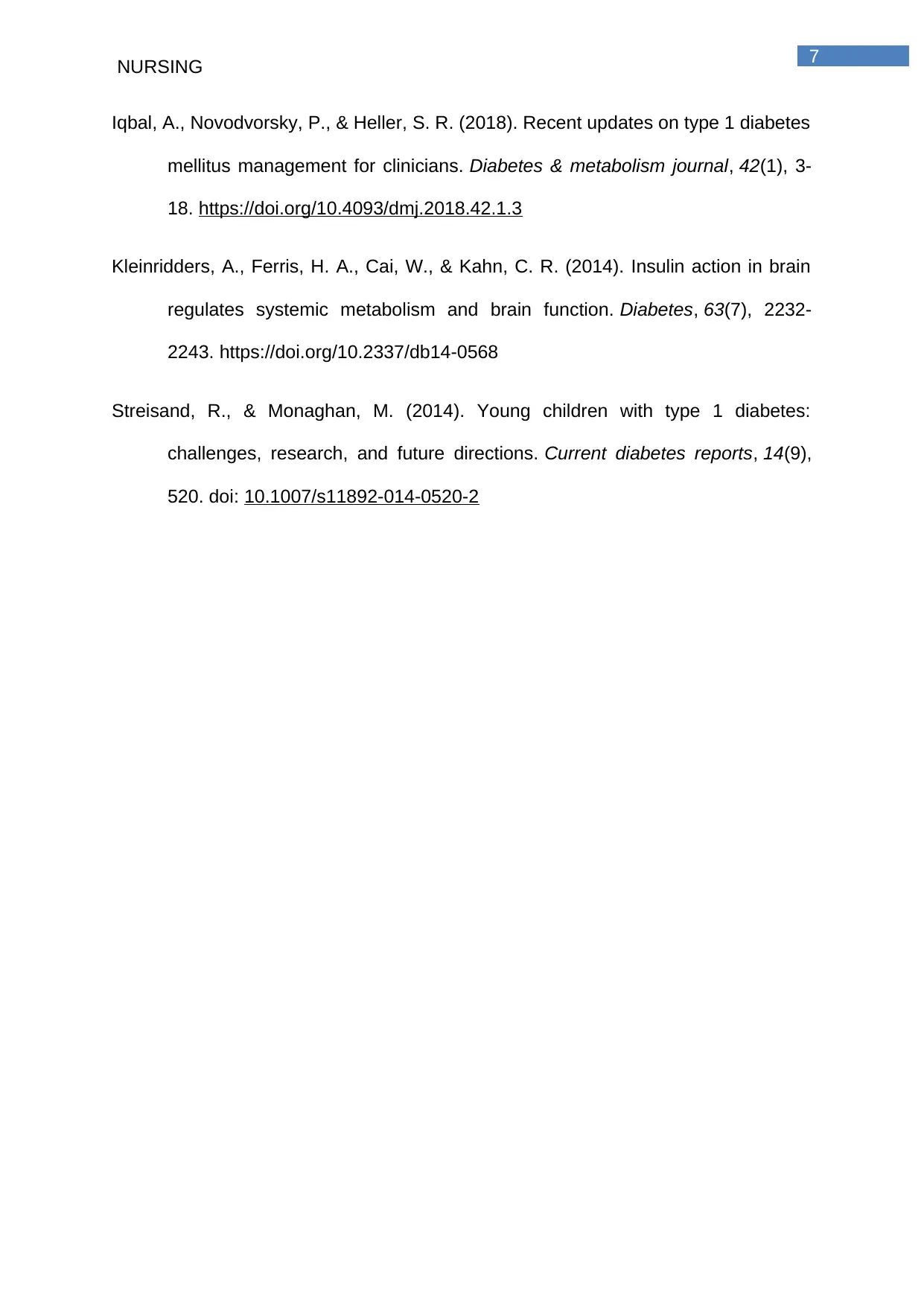
7
NURSING
Iqbal, A., Novodvorsky, P., & Heller, S. R. (2018). Recent updates on type 1 diabetes
mellitus management for clinicians. Diabetes & metabolism journal, 42(1), 3-
18. https://doi.org/10.4093/dmj.2018.42.1.3
Kleinridders, A., Ferris, H. A., Cai, W., & Kahn, C. R. (2014). Insulin action in brain
regulates systemic metabolism and brain function. Diabetes, 63(7), 2232-
2243. https://doi.org/10.2337/db14-0568
Streisand, R., & Monaghan, M. (2014). Young children with type 1 diabetes:
challenges, research, and future directions. Current diabetes reports, 14(9),
520. doi: 10.1007/s11892-014-0520-2
NURSING
Iqbal, A., Novodvorsky, P., & Heller, S. R. (2018). Recent updates on type 1 diabetes
mellitus management for clinicians. Diabetes & metabolism journal, 42(1), 3-
18. https://doi.org/10.4093/dmj.2018.42.1.3
Kleinridders, A., Ferris, H. A., Cai, W., & Kahn, C. R. (2014). Insulin action in brain
regulates systemic metabolism and brain function. Diabetes, 63(7), 2232-
2243. https://doi.org/10.2337/db14-0568
Streisand, R., & Monaghan, M. (2014). Young children with type 1 diabetes:
challenges, research, and future directions. Current diabetes reports, 14(9),
520. doi: 10.1007/s11892-014-0520-2
1 out of 8
Related Documents
Your All-in-One AI-Powered Toolkit for Academic Success.
+13062052269
info@desklib.com
Available 24*7 on WhatsApp / Email
![[object Object]](/_next/static/media/star-bottom.7253800d.svg)
Unlock your academic potential
© 2024 | Zucol Services PVT LTD | All rights reserved.





